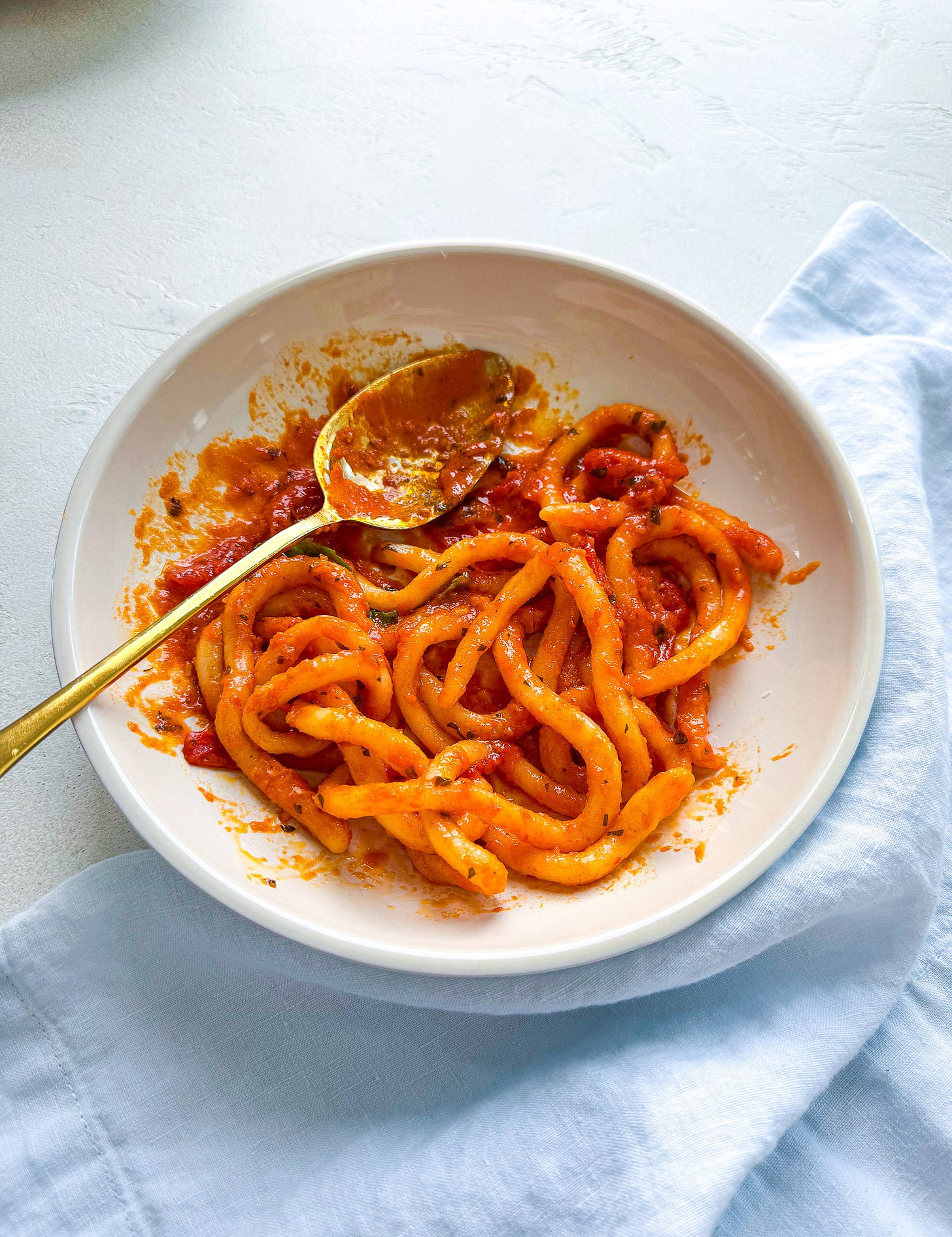Summer is here, and with it a familiar tale of two seasons: A season of simplicity, favoring food made with few, fresh ingredients and very little time. And a season of sociality, embracing thoughtful, unhurried meals made for gathering and spending warm evenings outdoors. In my house, this is generally an either/or situation—I’m either drizzling olive oil over thick slices of ripe tomatoes and calling it dinner, or spending two days making ice cream from scratch—but today I’m offering a recipe that aims to do both. It’s a dish with a short and accessible ingredient list (no eggs; no special equipment), a dish that takes time (but made all the quicker with the help of others), a dish that’s our June Pasta of the Month: umbricelli, chubby hand-rolled spaghetti from Umbria.
By now you know how these Pasta of the Month newsletters go. I’ll tell you about where the pasta came from, how it got its name, how it’s typically served. If I can, I’ll throw in a story about gluttonous priests and their vindictive constituents. And I will—I will do all of those things. But before I do, I want to skip the pasta for a moment, skip to the very end, and get one thing out of the way: This might very well be the best tomato sauce I’ve ever made. If you take anything away from my nerdy blathering, let it be this sauce. Make it; you will not regret it.
Okay, back to the pasta. If this is your first time coming across umbricelli, you might be familiar with their more-popular cousins, pici. Or perhaps you’ve heard of them by one of their other names, strangozzi (or stringozzi), ciriole, picchiarelli, or even, in the city of Orvieto, cavatelli. These pastas are, more or less, of the same genre: thick spaghetti-like strands rolled by hand. They are also, more or less, made with the same ingredients (flour and water) and found in the same (central) part of Italy. Whereas pici hail from Tuscany, and particularly Siena, umbricelli find their home next door, in Umbria, with both the cities of Spoleto and Foligno claiming their origins. This might seem obvious—umbricelli, Umbria—but the name has more to do with the pasta’s shape than its birthplace. Indeed, “umbricelli” comes from the local word for “earthworms,” which were beloved by the area’s peasant communities for enriching their soil. Not the most appetizing visual, though perhaps slightly better than strangozzi, from stringa, meaning “shoelace” or “string”—named after the preferred weapon of Umbrian anti-papal revolutionaries who used their leather laces to strangle members of the local clergy. (See? I told you we’d get the priests in there.) The most demure of the lot is ciriole, from the Latin cereus, meaning “waxen” or “candle-like,” referring to the dough’s pristine, wax-white color.
As with most pasta shapes, especially ones with pre-Roman roots like these, there are myriad variations from myriad towns, each made a little differently and with local flair. On the most basic level, umbricelli are thicker and shorter than pici (and, while we’re at it, strangozzi are slightly flatter than umbricelli), and the technique for making them is a bit more haphazard. (If you have my cookbook, you can, of course, use the pici instructions for these, too.) Still, umbricelli, like pici, can include different types of flour—not just soft wheat and durum wheat, but also alternative flours like farro, spelt, and chestnut—and their condiments are similar as well. You’ll find all manner of central Italian hand-rolled spaghetti served with tomato sauces, meat sauces, and mushroom sauces, the latter often with truffles. This might sound high-end, but umbricelli, pici, strangozzi, and all the rest are undoubtably peasant dishes, hallmarks of cucina povera, which make good use of leftovers and backyard ingredients. Ingredients that, in Umbria, include truffles.
Umbria is a treasure trove of Italian cuisine, the country’s landlocked “green heart” nestled between Tuscany, the Marche, and Lazio. The region itself is divided into two provinces: Perugia in the north and Terni in the south. And although it lacks glamorous coastlines and international borders, Umbria’s lush, hilly terrain is ripe with vineyards, olive groves, and fertile farmland. Its lakes (including Lake Trasimeno, one of Italy’s largest), woodlands, and medieval towns easily give the beauty—and food—of Tuscany a run for its money. Truffles might be the most famous of Umbria’s exports (the region produces more black truffles than any other part of Italy), but you’ll also find unmatched meats (particularly cured pork products), cheeses, vegetables, and lentils, like the ones from Castelluccio di Norcia, widely considered the best in the world.
In keeping with the rustic, vegetal spirit of Umbrian cooking, I was inspired to create a summery version of one of umbricelli’s classic accompaniments, sugo finto, meaning “fake sauce.” In Tuscany, you’ll often find sugo finto served with pici; there, it’s a slow-simmered sauce built like a ragù but without the meat. The familiar trio of carrots, celery, and onion make up the core of the dish, and are prepared as a “battuto” (minced together very finely) with parsley, rosemary, and sage, then enriched with red wine and tomatoes. In Umbria, sugo finto can also refer to a lighter tomato sauce, one with just a hint of wine and garlic and parsley instead of a battuto. I, of course, took the middle path and created an Umbrian-style, tomato-forward sauce with added body from typical battuto vegetables, with a totally different technique that does not involve making a battuto at all. The result is a delicious companion for both a summer of simplicity—fresh, easy—and a summer of sociality—deep, complex. Whether or not I’ve convinced you to gather your family and friends to make umbricelli (and I hope I have, for you already have everything you need—flour, water, and your own two hands), I do hope you’ll give the sauce a try. It might become your new favorite tomato sauce, as it has mine.
Umbricelli with Summer Sugo Finto
Serves 4






